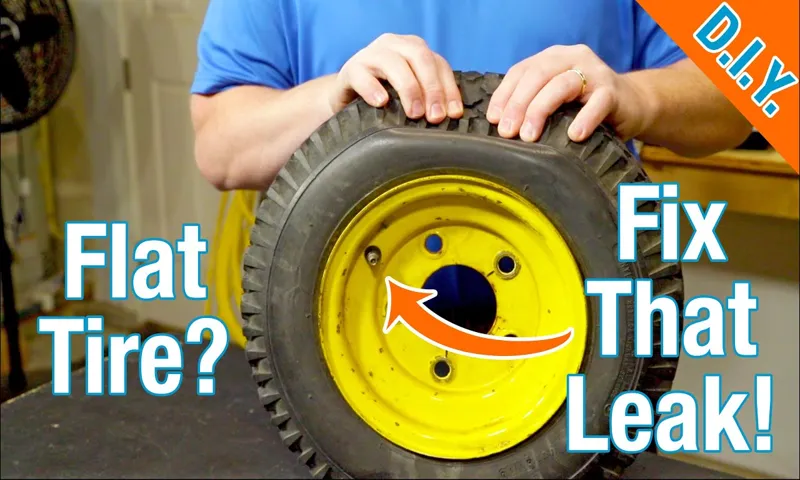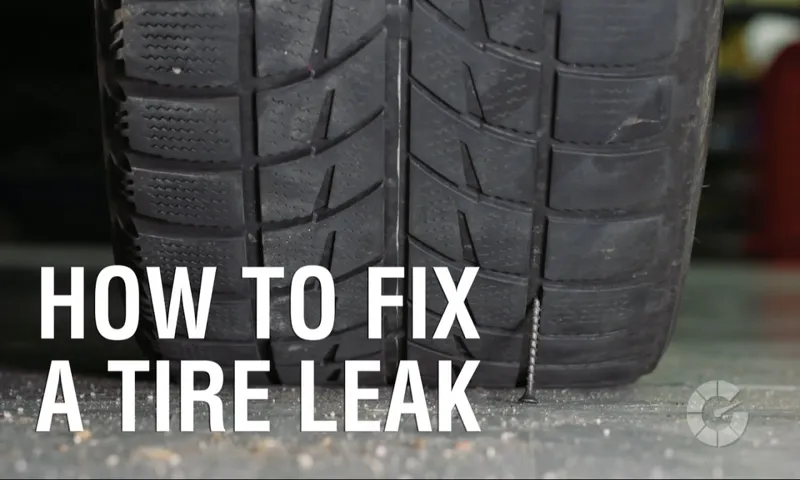Have you ever been driving along and suddenly realized that your tire pressure is lower than it should be? It’s a common problem that many people face, but it’s not something to be ignored. A tire leak can lead to serious issues, such as a blowout or decreased fuel efficiency. That’s why it’s important to know how to fix a tire leak as quickly as possible.
But where do you begin? Luckily, fixing a tire leak is a relatively simple process that can be done with a few basic tools and a little bit of know-how. In this step-by-step guide, we’ll walk you through the process of finding and repairing a tire leak, so you can get back on the road safely and with confidence. First, we’ll show you how to locate the leak by inspecting the tire and valve stem.
Then, we’ll guide you through the process of removing the tire and filling it with air to isolate the leak. We’ll also show you how to use a tire repair kit to fix the puncture and re-inflate the tire. By the end of this guide, you’ll have all the knowledge and tools you need to fix a tire leak quickly and easily.
So, let’s get started and take the first step towards being a pro at fixing tire leaks!
Table of Contents
Identify the Leak
If you’ve ever been in a situation where your tire slowly deflates over time, there’s a good chance that you have a tire leak. Having a leaky tire can be frustrating and potentially dangerous, but it’s not always obvious where the leak is coming from. The first step in fixing a tire leak is to identify where it’s coming from.
One way to do this is to put soapy water on the tire and look for bubbles – the bubbles will indicate where the air is escaping. Another method is to use a tire pressure gauge to check the pressure over time – if the pressure decreases rapidly, you probably have a leak. Once you’ve identified the source of the leak, you can determine the appropriate course of action, whether it’s a simple patch or a replacement tire.
Remember, driving on a leaky tire is never a good idea, so take care of the issue as soon as possible to ensure your safety on the road.
Inspect the tire for punctures or debris
When inspecting your tires, it’s essential to look for any signs of punctures or debris that might be causing a leak. It’s not always easy to identify where a leak is coming from, but there are a few things you can do to help pinpoint the problem. Start by examining the surface of the tire for any visible objects like nails, screws, or glass.
If you don’t see anything, move on to the tread and sidewall areas. Look for cuts or scrapes on the rubber surface, which could indicate a puncture. If you still can’t find the source of the leak, try spraying soapy water onto the tire.
The soap will create bubbles where the air is escaping, making it easier to locate the hole. Remember, even small punctures can cause a flat tire, so be thorough in your inspection. By identifying the leak early, you can take action to repair the tire before it causes more damage.

Check the valve stem for damage or looseness
When checking for a leak in your tire, it’s important to first identify where the leak is coming from. One possible culprit could be a damaged or loose valve stem. The valve stem is the component that allows air to be pumped into your tire, and if it’s not in proper condition, it can lead to air leaks.
To check the valve stem for damage, simply visually inspect it for any signs of cracks or breaks. If it appears to be in good condition, you should also check to make sure it’s secure and not loose. A loose valve stem can also cause air to escape from your tire.
By taking the time to carefully inspect and potentially fix any issues with your valve stem, you can avoid larger tire problems down the road. So, the next time you suspect a leak in your tire, don’t forget to give your valve stem a once-over.
Remove the Tire
Now that you’ve identified the source of the tire leak, let’s get to work fixing it. The first step is to remove the tire from the vehicle. You’ll need a few basic tools like a lug wrench and a jack.
Start by loosening the lug nuts but don’t remove them just yet. Then, use the jack to raise the car off the ground. Make sure to lift it high enough so that the tire can be easily removed.
Once the car is safely lifted, remove the lug nuts and gently pull the tire off. Be careful not to damage the valve stem or the rim. With the tire removed, you can inspect the tire for any visible damage or punctures.
This is a good time to also check the tire pressure and make sure it’s at the recommended level. With the tire off, you can now move on to fixing the leak.
Use a tire jack to lift the car
If you’re in need of removing a tire from your car, a tire jack will definitely come in handy. Firstly, ensure the car is in park or is on a level surface and the emergency brake is on. Then, locate the jack points indicated in your car’s manual.
Once found, position the tire jack properly and use it to lift the car off the ground. Make sure the jack is placed securely and is level before lifting the car any further. After lifting the car, remove the lug nuts by turning them counterclockwise with a socket wrench or tire iron.
Once removed, gently pull the tire off the hub by gripping it firmly and pulling it towards you. It’s important to remember to place the lug nuts somewhere safe, as they will be needed when putting the tire back on. By using a tire jack, removing a tire can be a relatively easy task that can be done on your own.
Loosen lug nuts and remove the tire
When it comes to changing a tire, one of the first steps is removing the old one. Before doing so, be sure to loosen the lug nuts with a lug wrench or tire iron. It’s important to do this before jacking up the car, as the weight of the car helps keep the tire in place while you’re removing the lug nuts.
Once the lug nuts are loosened, position the jack under the car in the designated spot and use it to lift the car off the ground. Once the car is lifted, finish removing the lug nuts and carefully remove the tire from the car. Be sure to inspect the tire for any signs of damage or wear, as this may indicate a larger issue with the vehicle’s suspension or alignment.
With the tire removed, you can now either replace it with a spare or take it to a mechanic for repair or replacement. Remember, safety is always the top priority when changing a tire, so take it slow and be careful when removing and installing the tire.
Locate the Leak
If you notice that your tire is losing air quickly, it’s important to locate the leak and fix it as soon as possible. The first step is to visually inspect the tire for any obvious punctures or tears, as these are often easy to spot. If you can’t see anything, try running your hand along the tire to feel for any abnormalities.
Another way to locate the leak is to use a soapy water solution. Apply the solution around the valve stem, tire bead, and any other areas that could be the source of the leak. If you see bubbles forming, you’ve found your leak.
Once you’ve located the leak, determine whether it can be patched or if you need to replace the tire. If it can be patched, clean the area around the leak and follow the patch kit instructions. If you need to replace the tire, choose a new one that matches the size and specifications of your old tire.
Remember, fixing a tire leak promptly can prevent further damage and keep you safe on the road.
Submerge the tire in water to locate the leak
If you suspect one of your tires has a leak, the best way to confirm your suspicions is to submerge the tire in water. Before you start, make sure the tire is deflated, disconnect it from the vehicle, and clean it thoroughly. Once the tire is clean and fully deflated, fill a container with water and submerge the tire completely.
As you rotate the tire, look carefully for bubbles – this indicates the source of the leak. Once you have located the leak, mark it with a piece of chalk or make a note of it. Be aware that some leaks may be difficult to find, so don’t be discouraged if you can’t find the source right away.
Keep in mind that this method is only effective for identifying leaks on the tire’s tread surface, and not for leaks on the sidewall or in the valve stem. If you cannot find the leak or feel uncertain about proceeding, it’s best to seek help from a tire professional.
Spray the tire with soapy water to find the leak
If you suspect that one of your tires is leaking air, there is a simple trick that you can use to locate the leak. Just spray the tire with soapy water! Start by mixing a small amount of dish soap with water in a spray bottle. Then, spray the soapy water onto the tire, focusing on the area where you suspect the leak is located.
The soap will create bubbles wherever there is a leak, making it easy to locate the problem. Remember to check the entire surface of the tire, including the valve stem, to ensure that you locate any and all leaks. Once you find the leak, you can either patch it if the hole is small enough, or replace the tire if the damage is too severe.
Keep in mind that driving on a tire that is leaking air can be dangerous, so it is important to fix the issue as soon as possible. By using this simple trick, you can easily locate the source of the leak and get your tire back to working properly in no time!
Patch or Replace the Tire
If you have noticed a tire leak, then your first step is to assess the severity of the damage. If the puncture is small, then you can try to patch the tire, but if it is too large or in an unsafe location, then replacing the tire may be necessary. To patch a tire, start by locating the puncture and removing any debris that may be stuck in the tire, then use a tire repair kit to patch the hole.
This will involve inserting a plug into the hole and then using a sealant to secure it in place. While patch kits can be a quick and easy fix, it’s important to note that they are only a temporary solution. Make sure to monitor your tire’s pressure and condition regularly and consider repairing or replacing the tire if the puncture is too big or located on the sidewall.
With proper maintenance and care, you can prevent future tire leaks and keep your vehicle running smoothly.
Repair the puncture with a patch kit
If you’ve ever experienced a flat tire, you understand how important it is to address the issue immediately. While some flats may require a replacement tire, many punctures can be easily repaired with a patch kit. Patching a tire instead of replacing it not only saves you money but also helps to reduce waste.
To patch a tire, begin by locating the puncture and removing any debris from the area. Next, rough up the area around the puncture with sandpaper and apply a rubber cement glue. Once the glue is dry, apply a patch over the puncture and firmly press it down.
The patch will bond with the tire, sealing the puncture and allowing you to continue driving safely. Be sure to monitor the patched area closely and take your vehicle to a professional if you notice any further issues. Overall, choosing to patch your tire instead of replacing it can be a convenient and eco-friendly solution.
Replace the tire if damage is too severe
If your tire is damaged, you may be wondering whether to patch or replace it. The answer depends on the severity of the damage. If the damage is minor, a patch may be sufficient.
However, if the damage is severe, it’s best to replace the tire altogether. Driving on a damaged tire can be dangerous, as it can lead to a blowout. Additionally, a damaged tire can cause your car to handle poorly, making it harder to control.
So, it’s important to get your tire inspected by a professional as soon as possible if you suspect damage. They can recommend the best course of action, whether it’s patching or replacing the tire altogether. Ultimately, your safety and the safety of your passengers should be the top priority.
Don’t take any chances with a damaged tire; have it checked out right away.
Reinstall and Inflate the Tire
If you find yourself with a tire leak, don’t worry, it’s an easy fix! First, locate the source of the leak by inspecting the tire’s tread for any foreign objects like nails or screws. Once you find the culprit, remove it carefully with pliers or a tire repair kit. Make sure there aren’t any other leaks by spraying soapy water around the tire and checking for bubbles.
Now that you’ve identified and removed the source of the leak, it’s time to reinstall and inflate the tire. First, you’ll need to replace the valve cap and reinstall the tire onto the wheel. Make sure that the tire is seated properly and that the valve is aligned with the hole in the rim.
Next, use a tire pressure gauge to check the pressure of the tire. Inflate the tire to the recommended pressure level as specified in the owner’s manual or on the tire sidewall. Finally, test the tire’s pressure again using the gauge and make sure it’s at the correct level.
By following these easy steps, you’ll be able to fix a tire leak and get back on the road in no time. Remember, it’s important to maintain proper tire pressure to ensure safe handling and prolong the life of the tire. Don’t forget to regularly check your tires for any signs of wear and tear to avoid future leaks.
Put tire back onto wheel hub and tighten the lug nuts
After successfully changing a tire, it’s important to ensure that it’s securely fastened back onto the wheel hub. Start by lining up the holes on the inner part of the tire with the studs on the wheel hub. Once they’re aligned, slide the tire onto the hub and finger-tighten the lug nuts.
Tighten each of the lug nuts in a star pattern to ensure that the tire is snugly fitted onto the hub. Then, using a lug wrench, tighten the lug nuts further until they’re completely secured. It’s crucial to make sure that the lug nuts are tightened correctly.
If they’re too loose, the tire could come off while driving, which can result in a dangerous accident. Alternatively, if they’re too tight, they can cause damage to the bolts or hubs, which can lead to costly repairs in the future. Once the tire is securely fastened to the hub, inflate the tire to the manufacturer’s recommended pressure using a tire pressure gauge.
This can be found in the owner’s manual or on a decal on the driver’s side door. By remembering to follow these steps, you can ensure that the tire is correctly installed and inflated, providing you with a safe and comfortable ride. Don’t forget to regularly check your tire’s pressure and condition to maintain optimal driving conditions.
With a little bit of effort and attention, you can avoid tire blowouts and enjoy a stress-free driving experience.
Use a tire pressure gauge to inflate tire to recommended level
When it comes to car maintenance, one important task that you should never overlook is checking your tire pressure. An overinflated or underinflated tire can cause a number of problems, including reduced fuel efficiency, poor handling, and even tire damage. To ensure that your tires are inflated to the recommended level, you’ll need to use a tire pressure gauge.
This handy tool measures the air pressure inside the tire and allows you to adjust it accordingly. To start, remove the valve cap from the tire and place the gauge over the valve stem. You should hear a brief hissing sound as air is released from the tire and into the gauge.
Once the gauge gives you a reading, compare it to the recommended tire pressure listed in your owner’s manual or on the side of your tire. If the reading is too low, use an air compressor to inflate the tire until it reaches the correct pressure. And if it’s too high, use the gauge to release some air until it reaches the recommended level.
By taking the time to properly inflate your tires, you’ll enjoy better performance and a safer driving experience on the road.
Monitor the Tire
Finding a tire leak may seem like a daunting task, but with a little patience, you can fix the problem yourself. One of the best things you can do is to regularly monitor your tire’s pressure. If you notice a slow leak, inflate the tire to the recommended pressure and mark it with chalk or a marker.
After a few days, check the tire again and see if the mark has moved or if the tire has lost pressure. If the mark has moved, this may indicate a leak. However, if the tire has lost pressure, there may be a deflated or damaged valve stem or a puncture.
In either case, it is important to get the tire fixed as soon as possible. If the leak is small, you may be able to use a tire sealant or patch kit to fix it, but if the leak is large or the tire is severely damaged, you may need to replace it. By regularly monitoring your tire pressure and taking prompt action when you notice a leak, you can keep your vehicle safe and avoid potentially costly repairs in the future.
Check tire pressure regularly to ensure it’s properly inflated
If you want to keep your car running smoothly and avoid frustrating breakdowns, monitoring the tire pressure should be a top priority. Many people overlook this aspect, but it’s critical to check the tires regularly to ensure they are properly inflated. If the pressure is too low, it can cause problems with the handling, reduce fuel efficiency, and increase the risk of a blowout.
On the other hand, overinflated tires can compromise your vehicle’s stability and traction, making it more challenging to steer and control. Therefore, it’s essential to follow the manufacturer’s recommendations for your car’s tire pressure and check it at least once a month or before a long road trip. You can use a tire pressure gauge to measure the air pressure accurately and adjust it as needed.
By monitoring the tire pressure proactively, you can extend the life of your tires, improve your car’s performance, and enhance your safety on the road.
Have tire professionally inspected if problem persists
The best way to ensure the safety of your vehicle is by keeping a close eye on your tires. If you notice any unusual vibration, bulges, or uneven wear, it’s important to have your tire professionally inspected. This will help you identify any potential issues and take the necessary precautions to prevent a blowout or other dangerous situation.
Monitoring the tire regularly can help prevent any disaster on the road. Remember that tires play a critical role in keeping you and your passengers safe on the road, so make sure to take the appropriate measures and schedule regular inspections. If the problem persists despite your efforts, don’t hesitate to have your tire professionally inspected to give you peace of mind.
Properly maintaining your tires helps ensure they last longer and performs better, allowing you to enjoy a smooth, safe ride. Stay vigilant and safe on the road by prioritizing your tire’s health, and you’ll be on your way to a worry-free drive.
Conclusion
In conclusion, if you want to fix a tire leak, just remember the 3 R’s: Remove, Rinse, and Repair. Remove the nail or debris causing the leak, rinse the area with soapy water to remove any dirt or grime, and then use a tire repair kit to patch up the hole. If that doesn’t work, well, there’s always the option of calling AAA and pretending that you have no clue what you’re doing.
But where’s the thrill in that? Fix that leak like a boss!”
FAQs
What are the common causes of tire leaks?
Tire leaks can be caused by punctures, damaged valve stems, corroded wheels, and worn-out tire treads.
How can I identify a tire leak?
You can identify a tire leak by checking for flat tires, low tire pressure, hissing sounds, or visibly damaged tires.
Can a tire leak be repaired or do I need to replace the tire?
This depends on the severity and location of the tire leak. If it is a small puncture in the tread area, it can usually be repaired. However, if the puncture is in the sidewall or the tire is severely damaged, replacement may be necessary.
How long does it take to fix a tire leak?
The time it takes to fix a tire leak depends on the severity of the leak, the location of the damage, and the availability of replacement parts. It can take anywhere from a few minutes to a few hours.
What tools do I need to fix a tire leak?
To fix a tire leak, you will need a tire gauge, an air compressor or tire inflator, tire sealant or repair kit, and possibly a jack and lug wrench if you need to remove the tire.
What should I do if I have a tire leak while driving?
If you notice a tire leak while driving, safely pull over to the side of the road as soon as possible. Avoid driving on the damaged tire as this can cause further damage and potentially lead to a blowout.
How can I prevent tire leaks in the future?
To prevent tire leaks, regularly check your tire pressure, inspect your tires for signs of damage or wear, avoid driving over rough terrain or sharp objects, and make sure your wheels are clean and free of corrosion.



